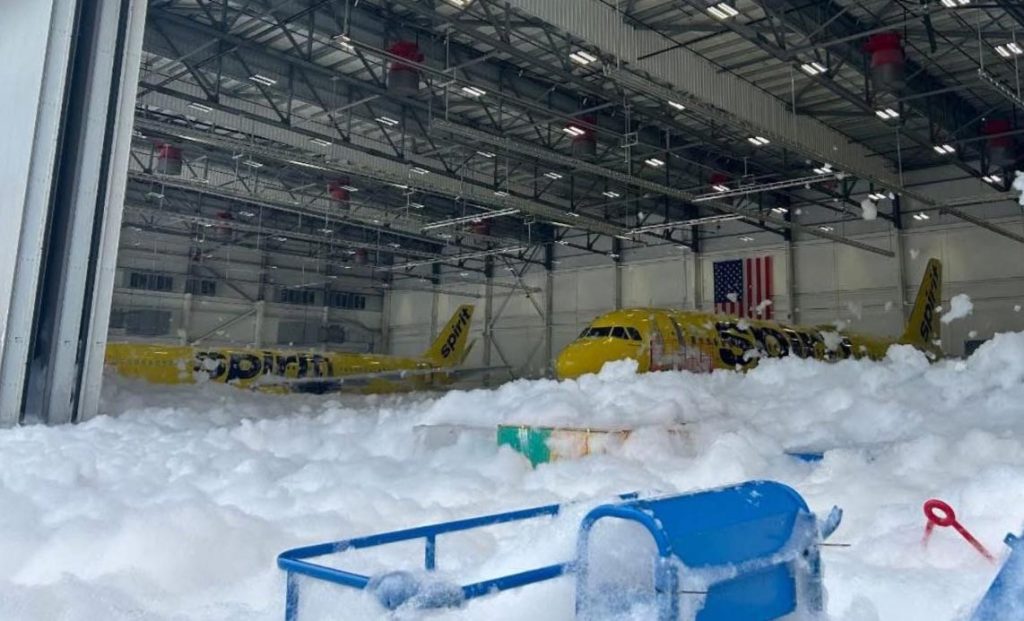Independence Day Foam Fallout: Accidental Fire Suppression Trigger Impacts Spirit Airlines Fleet at Detroit Metro Airport
July 4th, 2025, will be remembered not just for fireworks and celebrations, but also for an unexpected foam party at Spirit Airlines’ maintenance hangar at Detroit Metropolitan Wayne County Airport (DTW). An accidental activation of the hangar’s fire suppression system resulted in a massive discharge of fire-retardant foam, impacting multiple aircraft and requiring a significant response effort. This incident highlights the complexities of maintaining airport safety, the potential risks associated with fire suppression systems, and the potential for significant operational disruptions even with advanced safety infrastructure in place.
Lightning Suspected as Trigger for Foam Release
The event unfolded around 5 p.m. local time, coinciding with a passing lightning storm. While the exact cause is still under investigation, lightning is the prime suspect in triggering the fire suppression system. The hangar doors were open at the time, which resulted in the foam spilling beyond the confines of the building and onto the adjacent ramp area. The open doors, a common practice during maintenance to improve ventilation and allow for movement of equipment, unfortunately exacerbated the situation by allowing the foam to escape.
Aircraft Impacted: Both Inside and Outside the Hangar
The consequences of the accidental discharge were far-reaching. Inside the 126,000-square-foot hangar, two Airbus aircraft – an A321 and an A320 – were directly affected. Beyond the hangar walls, three additional aircraft parked on the ramp also fell victim to the foam’s reach. This highlights the scale of the event and the potential for widespread disruption to Spirit Airlines’ operations.
The planes parked outside may have been positioned there temporarily, awaiting maintenance or pre-flight checks. Regardless, the unexpected exposure to the fire suppression foam will necessitate a thorough inspection and cleaning process for each affected aircraft.
Understanding the Risks of Fire Suppression Foam
While designed to save lives and prevent catastrophic damage in the event of a fire, fire suppression foam is not without its own set of risks. The chemical composition of these foams is often highly corrosive, and prolonged exposure can lead to significant damage to aircraft components.
Potential damage includes:
- Engine Damage: The delicate internal components of aircraft engines are particularly vulnerable to corrosion from the foam. Ingestion of the foam into the engine could also cause significant operational problems.
- Electrical Systems: Electrical bays and wiring are susceptible to corrosion and short circuits upon contact with the foam. This could lead to complex and costly repairs.
- Cabin Interiors: Fabrics, upholstery, and sensitive electronic equipment within the cabin can be damaged by the corrosive properties of the foam.
- Structural Integrity: In extreme cases, prolonged exposure to certain types of fire suppression foam can even compromise the structural integrity of the aircraft’s skin.
The specific type of foam used in the fire suppression system at the Spirit Airlines hangar will be a key factor in determining the extent of the damage and the necessary remediation efforts.
Spirit’s Detroit Hub: A Critical Maintenance Facility
The hangar where the incident occurred is a critical piece of infrastructure for Spirit Airlines. Completed in 2017 at a cost of $32 million, this facility serves as a primary maintenance hub for the airline’s Airbus A320 and A321 CEO (Current Engine Option) and Neo (New Engine Option) fleet.
The hangar supports a wide range of maintenance activities, including:
- Scheduled and Unscheduled Maintenance: Routine inspections, repairs, and preventative maintenance.
- Engine Overhauls: Major repairs and refurbishment of aircraft engines.
- Cabin Modifications: Upgrades and alterations to cabin interiors.
The loss of functionality, even temporarily, of this maintenance hub will undoubtedly create logistical challenges for Spirit Airlines. They will need to reroute aircraft for maintenance, potentially leading to flight delays and cancellations.
Airport Authority Responds: Cleanup and Investigation Underway
The Wayne County Airport Authority (WCAA) fire and rescue crews responded swiftly to the incident, spending a significant portion of the day washing away the discharged foam. Their efforts were crucial in mitigating the environmental impact of the foam and preventing further damage to airport infrastructure.
In addition to the cleanup, the WCAA is likely conducting a thorough investigation to determine the root cause of the accidental activation. This investigation will likely involve reviewing the fire suppression system’s design and maintenance records, analyzing weather data to assess the likelihood of a lightning strike, and interviewing personnel who were present at the time of the incident.
Operational Impact and Financial Repercussions
The accidental foam discharge is expected to have a noticeable impact on Spirit Airlines’ operations. The affected aircraft will require thorough inspections, cleaning, and potentially extensive repairs. This translates to extended downtime for these aircraft, reducing the airline’s available fleet.
The grounding of these aircraft could lead to:
- Flight Delays and Cancellations: With fewer aircraft available, Spirit Airlines may be forced to delay or cancel flights, inconveniencing passengers and damaging the airline’s reputation.
- Increased Maintenance Costs: The inspection, cleaning, and repair of the affected aircraft will generate significant expenses.
- Potential Insurance Claims: Spirit Airlines will likely file an insurance claim to cover the costs associated with the incident.
- Logistical Challenges: The airline will need to find alternative maintenance facilities to handle the workload that would have been performed at the Detroit hub.
The financial ramifications of the incident could be substantial, impacting Spirit Airlines’ bottom line.
Fire Suppression Systems: A Necessary Evil?
This incident raises questions about the reliability and potential downsides of fire suppression systems in aviation settings. While these systems are undeniably crucial for protecting lives and property in the event of a fire, the potential for accidental activation and the associated risks cannot be ignored.
Key considerations:
- Redundancy and Safeguards: Are there sufficient redundancies and safeguards in place to prevent accidental activation? Are there manual overrides and monitoring systems that can quickly shut down the system in case of a false alarm?
- Maintenance and Testing: Is the fire suppression system regularly inspected and tested to ensure its proper functionality and to identify potential vulnerabilities?
- Foam Composition: Are there less corrosive alternatives to the traditional fire suppression foams that could be used in aviation settings?
- Training and Awareness: Are personnel adequately trained on the operation and potential risks associated with the fire suppression system?
Moving forward, a comprehensive review of fire suppression systems in aviation is warranted to identify areas for improvement and to minimize the risk of future incidents.
Looking Ahead: Lessons Learned and Mitigation Strategies
The accidental fire suppression trigger at Spirit Airlines’ Detroit maintenance hangar serves as a valuable learning experience for the entire aviation industry. It underscores the importance of robust safety protocols, regular system maintenance, and a thorough understanding of the risks associated with fire suppression systems.
Potential Mitigation Strategies:
- Enhanced Lightning Protection: Implement more robust lightning protection measures for airport hangars to minimize the risk of electrical surges triggering the fire suppression system.
- Improved System Monitoring: Install advanced monitoring systems that can detect and prevent accidental activation of the fire suppression system.
- Alternative Foam Technologies: Explore the use of more environmentally friendly and less corrosive fire suppression foams.
- Regular Training and Drills: Conduct regular training and drills to ensure that personnel are prepared to respond effectively to a fire suppression system activation, whether accidental or intentional.
- Emergency Response Planning: Develop comprehensive emergency response plans that address the potential consequences of a fire suppression system activation, including aircraft recovery, environmental cleanup, and operational disruption.
By taking these steps, the aviation industry can mitigate the risks associated with fire suppression systems and ensure the safety and efficiency of air travel. While the Independence Day foam fallout was an unfortunate event, it provides a crucial opportunity to learn and improve, ultimately contributing to a safer and more resilient aviation ecosystem.





